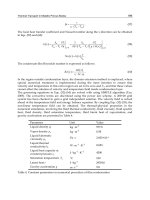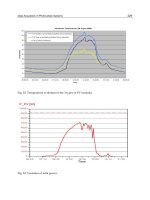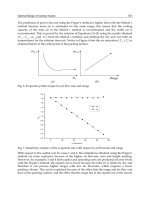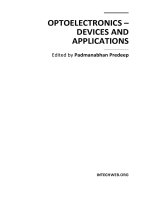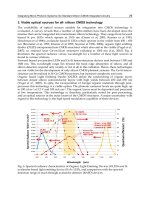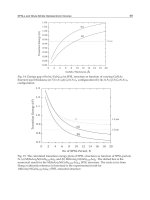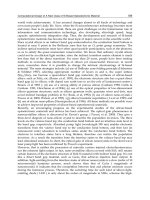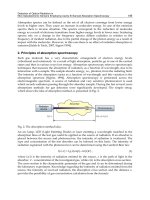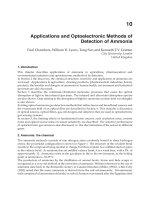Optoelectronics Devices and Applications Part 8 pot
Bạn đang xem bản rút gọn của tài liệu. Xem và tải ngay bản đầy đủ của tài liệu tại đây (1.26 MB, 40 trang )
Effects of Quantum-Well Base Geometry
on Optoelectronic Characteristics of Transistor Laser
269
Quantum-
Well
Position
(Å)
τ
B,spon
(ps)
ƒn (undamed
natural
ferquency)(GHz)
ξ (damping
ratio)
Simulated -3dB
Bandwidth(GHz)
150 0.54 125.8 1.7675 38.7
190 0.7 109.7 1.5595 39.3
290 1.11 87.5 1.2288 42.3
390 1.57 74 1.0365 45.2
490 2.1 64 0.9063 47.4
590 2.57 57 0.8103 48.9
690 3.03 53.5 0.7424 50.9
Table 1. Simulated device parameters for different W
EQW
; No resonance peak due to QW
movement when ξ≥0.7.
Fig. 11. QW location effect on optical bandwidth; an HBTL with well near its collector has
larger optical bandwidth while electrical bandwidth is the same.
5.1.4 Current gain
We predicted previously that optical bandwidth increment would be at cost of sacrificing
the current gain (β). Further investigation of QW effect on TL optoelectronic characteristics,
this time electrical, leads in an interesting result that matures the previous founding.
Collector current gain for an HBTL was calculated in subsection 4.2 in equations (24) and
(25). As a result of QW movement towards collector, simulation at constant bias currents
shows that τ
TL
and consequently β declines. Fig. 13 shows this change in optical bandwidth
and current gain versus displacement of QW while bias voltage, i.e. v
be
, forces base current
Optoelectronics – Devices and Applications
270
to be constant at I
B
=33mA for W
EQW
=590 Å. This bias enforcement does not disturb
generality of the simulation results.
The opposite dependence of BW and β to W
EQW
, is a trade-off between TL optoelectronic
characteristics. Other experimental and theoretical works proved the described “trade-off”
between β and f
-3db
as well (Then et al.,2009),(faraji et al., 2009). They also predict analytically
the above mentioned direct dependence of f
-3db
on τ
B,spon
. In (Then et al., 2008) the authors
utilized an auxiliary base signal to enhance the optical bandwidth. As a merge of their work
and the present analysis we can find the optimum place for QW that leads to better results
for both β and f
-3db
of a TL. It means we can use both method, i.e. auxiliary base signal and
QW dislocation method, simultaneously. A suggestion for finding an “optimum” QW
location consists of two steps . First we focus on β and make it larger by locating the QW
close to emitter, e.g. W
EQW
<300 Å, which results in BW<43 GHz. Then we use auxiliary AC
bias signal to trade some gain for BW. It should be noted that β less than unity is not
generally accepted if TL is supposed to work as an electrical amplifier.
Fig. 12. Calculated optical cut-off frequency (f
-3db
) versus τ
B,spon
. Bandwidth is maximum for
τ
B,spon
corresponding to W
EQW
≈730Å.
Effects of Quantum-Well Base Geometry
on Optoelectronic Characteristics of Transistor Laser
271
Fig. 13. Electrical gain-optical bandwidth trade-off in an HBTL.
5.2 Quantum-well width
Being an optical collector, the QW plays a significant role as it governs both optical and
electrical characteristics of TL. Among QW-base geometry parameters, other than QW
location, one can investigate the width of QW incorporated within the base region. For
instance, we can change the well width while other geometrical parameters, like QW
location, are left unchanged in order to examine how the optical frequency response and
current gain alter. Base minority carrier recombination lifetime was calculated before as in
equation (9) which was an independent function of well width. Charge control model and
charge analysis based on this model, described in previous sections, should be completed in
order to do this analysis. The base carrier lifetime, τ
B
, can be written as below (Then et al.,
2007c)
1
⁄
(28)
Where υ
th
is the thermal velocity of carriers, N
r
is the density of possible recombination sites
and σ is the cross section of carrier capture. σ is a measure of the region that an electron has
the possibility to capture and recombine with a hole and is proportional to well width
(W
QW
). In the other hand, N
r
depends on the hole concentration, i.e. N
A
of the base region.
So we can evaluate τ
B
as
1
⁄
(29)
where G is a proportionality factor defined by other geometrical properties of the base.
Using this equation one can extract base recombination lifetime of base minority carriers for
different base doping densities. Calculations exhibit an indirect relation between τ
B
and well
Optoelectronics – Devices and Applications
272
width, agreeing with a larger QW width enhancing the capture cross section for electrons.
Moreover, the larger N
A
, the greater the recombination and hence the smaller τ
B
.
The results for optical frequency response based on Statz-deMars equations of section 4 can be
utilized to evaluate the optical properties of a TL for varying well width. Indeed, equations
(13) and (14) require τ
B,spon
not τ
B
, as described above, therefore threshold current should be
calculated for different QW widths. An expression for base threshold current of TL is as below
⁄
1
(30)
where n
0
is minority carrier density in steady-state (under dc base current density of J
0
), τ
cap
is
the electron capture time by QW (not included in charge control model for simplicity), τ
qw
is
the QW recombination lifetime of electron and τ
rb0
is the bulk lifetime (or direct recombination
lifetime outside the well, also ignored in our model). The base geometry factor, ν, gives the
fraction of the base charge captured in the QW and defines as (Zhang & Leburton, 2009)
⁄
1
⁄
(31)
where W
qw
is the QW width, the factor we investigate here, W
b
is the base width and x
qw
is
the QW location, similar but not equal to previously defined parameter of W
EQW
. By setting
all the constants, one can calculate τ
B,spon
and then small-signal optical frequency response
and bandwidth of TL for a range of QW widths. Optimization is also possible like what we
did for QW location.
6. Conclusion and future prospects
An analytical simulation was performed to predict dependence of TL optoelectronic
characteristics on QW position in order to find a possible optimum place for QW. Simulated
base recombination lifetime of HBTL for different QW positions exhibited an increase in
optical bandwidth QW moved towards the collector within the base. Further investigations
of optical response prove the possibility of a maximum optical bandwidth of about 54GHz
in WEQW≈730 Å. Since no resonance peak occurred in optical frequency response, the
bandwidth is not limited in this method. In addition, the current gain decreased when QW
moved in the direction of collector. The above mentioned gain-bandwidth trade-off between
optoelectronic parameters of TL was utilized together with other experimental methods
reported previously to find a QW position for more appropriate performance. The
investigated transistor laser has an electrical bandwidth of more than 100GHz. Thus the
structure can be modified, utilizing the displacement method reported in this paper, to
equalize optical and electrical cut-off frequencies as much as possible.
In previous sections we consider the analysis of a single quantum well (SQW) where there is
just one QW incorporated within the base region. This simplifies the modelling and math-
related processes. In practice, SQWTL has not sufficient optical gain and may suffer thermal
heating which requires additional heat sink. Modifications needed to model a multiple QW
transistor laser (MQWTL). First one should rewrite the rate equations of coupled carrier and
photon for separate regions between wells. Solving these equations and link them by
applying initial conditions, i.e. continuity of current and carrier concentrations, is the next
step. In addition to multiple capture and escape lifetime of carriers, tunnelling of the 2-
dimensional carriers to the adjacent wells should be considered. For wide barriers one may
use carrier transport across the barriers instead the mentioned tunnelling. Simulation results
Effects of Quantum-Well Base Geometry
on Optoelectronic Characteristics of Transistor Laser
273
for diode laser (Duan et al., 2010), as one of the transistor laser parents, demonstrate
considerable enhancement in optical bandwidth and gain of the device when increasing the
number of quantum wells (Nagarajan et al., 1992), (Bahrami and Kaatuzian, 2010). Like the
well location modelled here in this chapter, there may be an optimum number of quantum
wells to be incorporated within the base region. Due to its high electrical bandwidth (≥100
GHz), it is needed to increase the optical modulation bandwidth of the TL. Base region plays
the key role in all BJT transistors, especially in Transistor Lasers.
Like Quantum-Well, base structural parameters have significant effects on optoelectronic
characteristics of TL which can be modelled like what performed before during this chapter.
Among these parameters are base width (Zhang et al., 2009), material, doping (Chu-Kung et
al., 2006), etc. For example, a graded base region can cause an internal field which
accelerates the carrier transport across the base thus alters both the optical bandwidth and
the current gain considerably.
7. References
Basu, R., Mukhopadhyay, B. & Basu, P.K. (2009). Gain Spectra and Characteristics of a
Transistor Laser with InGaAs Quantum Well in the Base. Proceeding of International
Conference on Computers and Devices for Communication, India, Dec. 2009
Bahrami Yekta, V. & Kaatuzian, H. (2010). Design considerations to improve high
temperature characteristics of 1.3μm AlGaInAs-InP uncooled multiple quantum
well lasers: Strain in barriers. Optik, Elsevier, doi:10.1016/j.ijileo.2010.03.016
Chan, R., Feng, M., Holonyak, N. Jr., James, A. & Walter, G. (2006). Collector current map of
gain and stimulated recombination on the base quantum well transitions of a
transistor laser. Appl. Phys. Lett., Vol. 88, No. 143508
Chu-kung, B.F., Feng, M., Walter, G., Holonyak, N. Jr., Chung, T., Ryou, J H., Limb, J., Yoo,
D., Shen, S.C. & Dupuis, R.D. (2006). Graded-base InGaN/GaN heterojunction
bipolar light-emitting transistors. Appl. Phys. Lett. Vol. 89, No. 082108
Dixon, F., Feng, M. & Holonyak, N. Jr. (2010). Distributed feedback transistor laser. Appl.
Phys. Lett. Vol. 96, No. 241103
Dixon, F., Chan, R., Walter, G., Holonyak, N. Jr. & Feng, M. (2006). Visible spectrum light-
emitting transistors. Appl. Phys. Lett. Vol. 88, No. 012108
Duan, Z., Shi, W., Chrostowski, L., Huang, X., Zhou, N., & Chai, G. (2010). Design and
epitaxy of 1.5 μm InGaAsP-InP MQW material for a transistor laser. Optics Express,
Vol. 18, Issue 2, pp. (1501-1509), doi:10.1364/OE.18.001501
Faraji, B., Pulfrey, D.L. & Chrostowski, L. (2008). Small-signal modeling of the transistor
laser including the quantum capture and escape lifetimes. Appl. Phys. Lett., Vol. 93,
No. 103509
Faraji, B., Shi, W., Pulfrey, D.L. & Chrostowski, L. (2009). Analytical modeling of the
transistor laser. IEEE Journal of Quantum Electron., Vol. 15, No. 3, pp (594-603)
Feng, M., Holonyak, N. Jr. & Hafez, W. (2004a). Light-emitting transistor: light emission from
InGaP/GaAs heterojunction bipolar transistors. Appl. Phys. Lett. Vol. 84, No. 151
Feng, M., Holonyak, N. Jr. & Chan, R. (2004b). Quantum-well-base heterojunction bipolar
light-emitting transistor. Appl. Phys. Lett., Vol. 84, No. 11
Feng, M., Holonyak, N. Jr., Walter, G. & Chan, R. (2005). Room temperature continuous
wave operation of a heterojunction bipolar transistor laser. Appl. Phys. Lett. Vol. 87,
No. 131103
Optoelectronics – Devices and Applications
274
Feng, M., Holonyak, N. Jr., Chan, R., James, A. & Walter, G. (2006a). Signal mixing in a
multiple input transistor laser near threshold. Appl. Phys. Lett. Vol. 88, No. 063509
Feng, M., Holonyak, N. Jr., James, A., Cimino, K., Walter, G. & Chan, R. (2006b). Carrier
lifetime and modulation bandwidth of a quantum well AlGaAs/
InGaP/GaAs/InGaAs transistor laser. Appl. Phys. Lett. Vol. 89, No. 113504
Feng, M., Holonyak, N. Jr., Then, H.W. & Walter, G. (2007). Charge control analysis of
transistor laser operation. Appl. Phys. Lett. Vol. 91, No. 053501
Feng, M., Holonyak, N. Jr., Then, H.W., Wu, C.H. & Walter, G. (2009). Tunnel junction
transistor laser. Appl. Phys. Lett. Vol. 94, No. 041118
Kaatuzian, H. (2005). Photonics, Vol. 1, AmirKabir University of Technology press, , Tehran, Iran
Kaatuzian, H. & Taghavi,I. (2009). Simulation of quantum-well slipping effect on optical
bandwidth in transistor laser. Chinese optics letters. doi:10.3788/COL20090705.0435,
pp. 435–436
Nagarajan, R., Ishikawa, M., Fukushima, T., Geels, R. & Bowers, E. (1992). High speed
quantum-well lasers and carrier transport effects. IEEE Journal of Quantum Electron,
Vol. 28, No. 10, pp (1990-2008)
Shi, W., Chrostowski, L & Faraji, B. (2008). Numerical Study of the Optical Saturation and
Voltage Control of a Transistor Vertical-Cavity Surface-Emitting Laser. IEEE
Photonics Technology Letters, Vol. 20, No. 24
Suzuki, Y., Yajima, H., Shimoyama, K., Inoue, Y., Katoh, M. & Gotoh, H. (1990).
(Heterojunction field effect transistor laser). Ellectronics Letters, Vol. 26, No. 19
Taghavi,I & Kaatuzian, H. (2010). Gain-Bandwidth trade-off in a transistor laser : quantum
well dislocation effect. Springer, Opt Quant Electron. doi: 10.1007/s11082-010-9384-0,
pp. 481–488
Then, H.W., Walter, G., Feng, M. & Holonyak, N. Jr. (2007a). Collector characteristics and
the differential optical gain of a quantum-well transistor laser. Appl. Phys. Lett Vol.
91, No. 243508
Then, H.W., Feng, M. & Holonyak, N. Jr. (2007b). Optical bandwidth enhancement by
operation and modulation of the first excited state of a transistor laser. Appl. Phys.
Lett. Vol. 91, No. 183505
Then, H.W., Feng, M., Holonyak, N. Jr. & Wu, C.H. (2007c). Experimental determination of
the effective minority carrier lifetime in the operation of a quantum-well n-p-n
heterojunction bipolar light-emitting transistor of varying base quantum-well
design and doping. Appl. Phys. Lett. Vol. 91, No. 033505
Then, H.W., Walter, G., Feng, M. & Holonyak, N. Jr. (2008). Optical bandwidth enhancement
of heterojunction bipolar transistor laser operation with an auxiliary base signal.
Appl. Phys. Lett. Vol. 93, No. 163504
Then, H.W., Feng, M. & Holonyak, N. Jr. (2009). Bandwidth extension by trade-off of
electrical and optical gain in a transistor laser: three-terminal control. Appl. Phys.
Lett. Vol. 94, No. 013509
Then, H.W., Feng, M. & Holonyak, N. Jr. (2010). Microwave circuit model of the three-port
transistor laser. Appl. Phys. Lett. Vol. 107, No. 094509
Walter, G., Holonyak, N. Jr., Feng, M. & Chan, M. (2004). Laser operation of a heterojunction
bipolar light-emitting transistor. Appl. Phys. Lett
. Vol. 85, No. 4768
Walter, G., James, A., Holonyak, N. Jr., Feng, M. & Chan, R. (2006). Collector breakdown in
the heterojunction bipolar transistor laser. Appl. Phys. Lett. Vol. 88, No. 232105
Zhang, L. & Leburton, J P. (2009). Modeling of the transient characteristics of heterojunction
bipolar transistor lasers. IEEE Journal of Quantum Electron.
doi:10.1109/JQE.2009.2013215, pp. (359–366)
14
Intersubband and Interband Absorptions
in Near-Surface Quantum Wells
Under Intense Laser Field
Nicoleta Eseanu
Physics Department, “Politehnica” University of Bucharest,
Bucharest
Romania
1. Introduction
The intersubband transitions in quantum wells have attracted much interest due to their
unique characteristics: a large dipole moment, an ultra-fast relaxation time, and an
outstanding tunability of the transition wavelengths (Asano et al., 1998; Elsaesser, 2006;
Helm, 2000). These phenomena are not only important by the fundamental physics point of
view, but novel technological applications are expected to be designed.
Many important devices based on intersubband transitions in quantum well
heterostructures have been reported. For example: far- and near-infrared photodetectors
(Alves et al., 2007; Levine, 1993; Li, S.S. 2002; Liu, 2000; Schneider & Liu, 2007; West &
Eglash, 1985), ultrafast all-optical modulators (Ahn & Chuang, 1987; Carter et al., 2004; Li, Y.
et al., 2007), all optical switches (Iizuka et al., 2006; Noda et al., 1990), and quantum cascade
lasers (Belkin et al., 2008; Chakraborty & Apalkov, 2003; Faist et al., 1994).
It is well-known that the optical properties of the quantum wells mainly depend on the
asymmetry of the confining potential experienced by the carriers. Such an asymmetry in
potential profile can be obtained either by applying an electric/laser field to a symmetric
quantum well (QW) or by compositionally grading the QW. In these structures the changes
in the absorption coefficients were theoretically predicted and experimentally confirmed to
be larger than those occurred in conventional square QW (Karabulut et al., 2007; Miller,
D.A.B. et al., 1986; Ozturk, 2010; Ozturk & Sökmen, 2010).
In recent years, with the availability of intense THz laser sources, a large number of strongly
laser-driven semiconductor heterostructures were investigated (Brandi et al., 2001; Diniz
Neto & Qu, 2004; Duque, 2011; Eseanu et al., 2009; Eseanu, 2010; Kasapoglu & Sokmen,
2008; Lima, F. M. S. et al., 2009; Niculescu & Burileanu, 2010b; Ozturk et al., 2004; Ozturk et
al., 2005; Sari et al., 2003; Xie, 2010).
These works have revealed important laser-induced effects:
i) the confinement potential is dramatically modified; ii) the energy levels of the electrons
and, to a lesser extent, those of the holes are enhanced; iii) the linear and nonlinear
absorption coefficients can be easily controlled by the confinement parameters in
competition with the laser field intensity.
The intersubband transitions (ISBTs) have been observed in many different material
systems. In recent years, apart from GaAs/AlGaAs, the InGaAs/GaAs QW structures have
Optoelectronics – Devices and Applications
276
attracted much interest because of their promising applications in optoelectronic and
microelectronic devices: multiple-quantum-well modulators and switches (Stohr et al.,
1993), broadband photodetectors (Gunapala et al., 1994; Li J. et al., 2010, Passmore, et al.,
2007), superluminescent diodes used for optical coherence tomography (Li Z. et al., 2010)
and metal-oxide-semiconductor field-effect-transistors, i. e. MOSFETs (Zhao et al., 2010).
The optical absorption associated with the excitons in semiconductor QWs have been the
subject of a considerable amount of work for the reason that the exciton binding energy and
oscillator strength in QWs are considerably enhanced due to quantum confinement effect
(Andreani & Pasquarello, 1990; Jho et al., 2010; Miller, R. C. et al., 1981; Turner et al., 2009;
Zheng & Matsuura, 1998).
As a distinctive type of dielectric quantum wells, the near-surface quantum wells (n-sQWs)
have involved increasing attention due to their potential to sustain electro-optic operations
under a wide range of applied electric fields. In these heterostructures the QW is located
close to vacuum and, as a consequence, the semiconductor-vacuum interface which is
parallel to the well plane introduces a remarkable discrepancy in the dielectric constant
(Chang & Peeters, 2000). This dielectric mismatch leads to a significant enhancement of the
exciton binding energy (Gippius et al., 1998; Kulik et al., 1996; Niculescu & Eseanu, 2010a)
and, consequently, it changes the exciton absorption spectra as some experimental (Gippius
et al., 1998; Kulik et al., 1996; Li, Z. et al., 2010; Yablonskii et al., 1996) and theoretical
(Niculescu & Eseanu, 2011a; Yu et al., 2004) studies have demonstrated.
The rapid advances in modern growth techniques and researches for InGaAs/GaAs QWs
(Schowalter et al., 2006; Wu, S. et al., 2009) create the possibility to fabricate such
heterostructures with well-controlled dimensions and compositions. Therefore, the
differently shaped InGaAs/GaAs near-surface QWs become interesting and worth studying
systems.
We expect that the capped layer of these n-sQWs induces considerable modifications on the
intersubband absorption as it did on the interband excitonic transitions (Niculescu &
Eseanu, 2011). To the best of our knowledge this is the first research concerning the intense
laser field effect on the ISBTs in InGaAs/GaAs differently shaped near-surface QWs.
In this chapter we are concerned about the intersubband and interband optical transitions in
differently shaped n-sQWs with symmetrical/asymmetrical barriers subjected to intense
high-frequency laser fields. We took into account an accurate form for the laser-dressing
confinement potential as well as the occurrence of the image-charges. Within the framework
of a simple two-band model the consequences of the laser field intensity and carriers-surface
interaction on the absorption spectra have been investigated.
The organization of this work is as follows. In Section 2 the theoretical model for the intense
laser field (ILF) effect on the intersubband absorption in differently shaped n-sQWs is
described together with numerical results for the electronic energy levels and absorption
coefficients (linear and nonlinear). In Section 3 we explain the ILF effect on the exciton
ground energy and interband transitions in the same QWs, taking into account the repulsive
interaction between carriers and their image-charges. Also, numerical results for the 1S-
exciton binding energy and interband linear absorption coefficient are discussed. Finally,
our conclusions are summarized in Section 4.
2. Intersubband transitions in near-surface QWs under intense laser field
The intersubband transitions (ISBTs) are optical transitions between quasi-two-dimensional
electronic states ("subbands") in semiconductors which are formed due to the confinement
Intersubband and Interband Absorptions in
Near-Surface Quantum Wells Under Intense Laser Field
277
of the electron wave function in one dimension. The conceptually simplest band-structure
engineered system that can be fabricated is a quantum well (QW), which consists of a thin
semiconductor layer embedded in another semiconductor with a larger bandgap.
Depending on the relative band offsets of the two semiconductor materials, both electrons
and holes can be confined in one direction in the conduction band (CB) and the valence
band (VB), respectively. Thus, allowed energy levels which are quantized along the growth
direction of the heterostructure appear (Yang, 1995). These levels can be tailored by
changing the QW geometry (shape, width, barrier heights) or by applying external
perturbations (hydrostatic pressure, electric, magnetic and laser fields). Whereas, of course,
optical transitions can take place between VB and CB states, in this Section we are
concerning only with ISBTs between quantized levels within the CB.
2.1 Theory
Let us consider an InGaAs n-sQW embedded between symmetrical/asymmetrical GaAs
barriers. It is convention to define the QW growth as the z-axis. According to the effective
mass approximation, in the absence of the laser field, the time-independent Schrödinger
equation is
22
2
2
self
zVzVz zEz
mz
. (1)
where
m is the electron effective mass,
Vz is the confinement potential in the QW
growth direction and
self
Vz describes the repulsive interaction in the system consisting of
an electron and its image-charge.
2
0
0
11
212
self
e
Vz
d
. (2)
Here
is the semiconductor dielectric constant,
22
0
/4ee
, and
0
d
is the distance between
the electron and its image-charge without laser field. For the three differently shaped n-
sQWs studied in this work the potential
Vz reads as follows. For a square n-sQW,
Vz
has the well-known form
0
,
,0
0, 0
c
SQW
cw
w
zL
VzV LzandzL
zL
` (3a)
For a graded n-sQW, the confinement potential is
0
0
,
,0
,0
2
,
c
c
GQW
rw
w
rw
zL
VLz
Vz
z
VzL
L
VV zL
(3b)
Optoelectronics – Devices and Applications
278
For a semiparabolic n-sQW,
Vz
is given by
0
2
0
,
,0
,0
,
c
c
sPQW
rw
w
rw
zL
VLz
Vz
z
VzL
L
VV zL
(3c)
The quantities
w
L and
c
L are the well width and capped layer thicknesses, respectively;
0
V
is the GaAs barrier height in the QW left side (with cap layer);
r
V is the barrier height in the
QW right side and is the barrier asymmetry parameter.
Under the action of a non-resonant intense laser field (ILF) represented by a monochromatic
plane wave of frequency
LF
having the vector potential
0
cos
LF
At uA t
, the
Schrödinger equation to be solved becomes a time-dependent one due to the time-
dependent nature of the radiation field. Here
u is the unit vector of the polarization
direction (chosen as z-axis). By applying the translation
rr t
the equation
describing the electron-field interaction dynamics was transformed by Kramers (Kramers,
1956) as
2
,,,
2
rt Vr t rt i rt
t
m
. (4)
The expression
0
α sin
LF
tu t
(5)
describes the quiver motion of the electron under laser field action.
0
is known as the
laser-dressing parameter, i. e. a laser-dependent quantity which contains both the laser
frequency and intensity,
0
0
LF
eA
m
. (6)
Thus, in the presence of the laser field linearly polarized along the
z-axis, the confinement
potential
Vz t
is a time-periodic function for a given z and it can be expanded in a
Fourier series,
0
1expexp
v
kv LF
kv
Vz t VJ k ikz iv t
(7)
where
k
V is the k-th Fourier component of
Vz and
v
J is the Bessel function of order v. In
the high-frequency limit, i.e.
1
LF
, with τ being the transit time of the electron in the
QW region (Marinescu & Gavrila, 1995) the electron “sees” a laser-dressed potential which
is obtained by averaging the potential
Vz t
over a laser field period,
Intersubband and Interband Absorptions in
Near-Surface Quantum Wells Under Intense Laser Field
279
2/
000
0
,exp.
2
LF
LF
k
k
Vz Vz t dt VJ k ikz
(8)
Note that this approximation remains valid provided that the laser is tuned far from any
resonance so that only photon absorption was taken into account and photon emission was
disregarded.
Following some basic works (Gavrila & Kaminski, 1984; Lima, C.A.S. & Miranda, 1981;
Marinescu & Gavrila, 1995) the laser-dressed electronic eigenstates in the QW are the
solutions of a time-independent Schrödinger equation,
2
~~
0
1
,
2
dd
Vz z E z
dz dz
mz
. (9)
Here
~
z
is the laser-dressed wave function of the electron. The envelope wave functions
and subband energies in this modified potential can be obtained by using a transfer matrix
method (Ando & Ytoh, 1987; Tsu & Esaki, 1973).
In order to characterize the intersubband transitions in laser-dressed n-sQWs the
12
EE
transition energy,
21
tr
EEE, and square of the optical matrix element,
2
21
M
, are worth
being calculated. Our results for n-sQWs revealed that these quantities depend on the QW
width and shape as well as on laser field parameter and cap layer thickness.
The dipole matrix element of the
i
f
EE transition is defined by
*
fi f i
M
ez dz
(10)
Also, the first-order absorption coefficient,
1
ex
, and the third-order absorption
coefficient,
3
,
ex
I
, for an optical transition between two subbands can be calculated by
using the compact density matrix method (Bedoya & Camacho, 2005; Rosencher & Bois,
1991) and a typical iterative procedure (Ahn & Chuang, 1987). The linear and nonlinear
absorption coefficients are written (Unlu et al., 2006; Ozturk, 2010) as:
*
2
1
21
2
1
22
2
21
1exp /
/
ln
1exp /
/
B
ex
eff
FB
ex in
FB
ex in
mkT
M
L
EE kT
EE kT
EE
(11)
*
2
3
21
2
0
1
2
22
2
21
,
2
1exp /
/
ln
1exp /
/
B
ex
r
eff
FB
ex in
FB
ex in
ImkT
IM
nc
L
EE kT
EE kT
EE
Optoelectronics – Devices and Applications
280
2
2
22 11
21
2
2
21
22
21 2121
4
/
/2
in
ex in ex
MM
M
EE
EE EEEE
(12)
Here
I is the optical intensity of the incident electromagnetic wave (with the angular
frequency
ex
) that excites the semiconductor nanostructure and leads to the intersubband
optical transition,
is the permeability,
2
0
r
n
with
r
n being the refractive index,
ex
is
the pump photon energy produced by a tunable laser source,
F
E represents the Fermi
energy,
1
E and
2
E denote the quantized energy levels for the initial and final states,
respectively;
B
k and T are the Boltzmann constant and temperature, respectively, c is the
speed of light in free space,
e
ff
L
is the effective spatial extent of the electrons and
in
is the
intersubband relaxation time.
The total absorption coefficient is given by
13
,,
ex ex ex
II
(13)
The absorbtion coefficients in n-sQWs under laser field depend on both laser-dressing
parameter and QW geometry (well shape, barrier asymmetry, cap layer thickness).
2.2 Electronic properties
2.2.1 Laser-dressed confinement potential and energy levels
Within the framework of effective-mass approximation the ground and the first excited
energetic levels for an electron confined in differently shaped In
0.18
Ga
0.82
As/GaAs near-
surface QWs: square (SQW), graded (GQW), and semiparabolic (sPQW) under
high-frequency laser field were calculated. We used various QW widths
L = 100 Å, 150 Å,
and 200 Å, different cap layer thicknesses,
c
L
, between 5 Å and 200 Å, for n-sQWs with
symmetrical ( = 1) or asymmetrical ( = 0.6 and 0.8) barriers. The small In atoms
concentration in the QW layer allowed us to take the same value of the electron effective
mass in all regions (barriers, QW), i. e.
0
0.0665
mm. Also, we used
F
E
= 6.49 meV which
corresponds to about 1
.6 × 10
17
electrons/cm
3
in GaAs, and
in
= 0.14 ps (Ahn & Chuang,
1987).
Fig. 1 displays the “dressed” potential profiles of the conduction band (CB) for three
differently shaped n-sQWs (SQW, GQW and sPQW) with QW width
w
L
= 150 Å, identical
barriers ( = 1) and cap layer thickness
c
L
= 20 Å, under various laser intensities described
by the laser parameter values
0
= 0; 40; 80 and 100 Å. Only two energy levels have been
taken into account for all the n-sQWs investigated in this work:
1
E
(ground state) and
2
E
(first excited state). They are are plotted in Fig. 1, too.
We see that for all studied n-sQWs the increasing of the laser parameter dramatically
modifies the potential shape which is responsible for quantum confinement of the electrons.
Up to
0
/2
w
L
two effects are noticeable: i) while the effective “dressed” well width (i. e.
the lower part of the confinement potential) decreases with the laser intensity, the width of
the upper part of this “dressed” QW increases; ii) a reduction of the effective well height at
the interface between the capped layer and the QW (
z = 0).
Intersubband and Interband Absorptions in
Near-Surface Quantum Wells Under Intense Laser Field
281
Fig. 1. (Color online) Laser-dressed confinement potentials of three differently shaped
In
0.18
Ga
0.82
As/GaAs near-surface QWs with identical barriers and the corresponding energy
levels: ground state
1
E
(solid lines) and first excited state
2
E
(dashed lines). Notations a, c,
e, and f stand for various laser parameter values,
0
= 0 (black), 40 Å (olive), 80 Å (purple),
and 100 Å (orange), respectively. QW width and cap layer thickness are
w
L
= 150 Å and
c
L
= 20 Å, respectively.
Optoelectronics – Devices and Applications
282
Therefore, under an intense laser field a distinctive blue-shift of the electronic energy levels
occurs, as expected (Brandi et al., 2001; Diniz Neto & Qu, 2004; Eseanu, 2010; Kasapoglu &
Sökmen, 2008; Lima, F. M. S. et al., 2009; Niculescu & Burileanu, 2010b; Ozturk et al., 2004;
Ozturk et al., 2005). This laser-induced push-up effect is more pronounced in the
semiparabolic QW due to the stronger geometric confinement.
For
2
0
/
w
L
a supplementary barrier having a “hill”-form appears into the well region
and, as a consequence, the formation of a double well potential in the InGaAs layer is
predicted. Similar laser-induced phenomena were reported for a GaAs/AlGaAs square QW
(Lima, F. M. S. et al., 2009) and for coaxial quantum wires (Niculescu & Radu, 2010c).
The two energy levels
1
E
(ground state) and
2
E
(first excited state) depend on both laser
field characteristics (frequency and intensity, combined in the laser parameter) and QW
confining geometry (shape, width, cap layer thickness and barrier asymmetry).
In Figs. 2 A-C the energy levels
1
E
and
2
E
are plotted as functions of laser parameter in
three differently shaped n-sQWs (SQW, GQW and sPQW) with
w
L
= 200 Å for various cap
layer thicknesses.
We observed that:
i.
the laser-induced increasing of the ground level energy
1
E
is more pronounced for
0
40 Å in all three differently shaped n-sQWs with the same
w
L
;
ii.
the first excited level energy
2
E
is almost unaltered by the laser field in the GQW and
sPQW for
0
40 Å; instead, in the SQW,
2
E
has a significant rising.
The reasons are as follows: i) the ground level
1
E
is localized in the lower part of the laser-
dressed QW and it is significantly moved up only by an intense laser field; ii) in the GQW
and sPQW the stronger geometric confinement competes with the laser-induced push-up of
the energy levels. As a consequence, the excited level which is localized in the upper part
becomes less sensitive to the laser action.
0 20 40 60 80 100 120
10
20
30
40
50
60
70
A
L
c
L
c
E
1
E
2
SQW
L
w
=200Å
E
1
,E
2
[meV]
0
[Å]
Fig. 2. A
Intersubband and Interband Absorptions in
Near-Surface Quantum Wells Under Intense Laser Field
283
0 20 40 60 80 100 12
0
40
50
60
70
80
90
B
L
c
L
c
E
1
E
2
GQW
L
w
=200Å
E
1
,E
2
[meV]
0
[Å]
0 20 40 60 80 100 120
40
60
80
100
C
L
c
L
c
E
1
E
2
sPQW
L
w
=200Å
E
1
,E
2
[meV]
0
[Å]
Fig. 2. Energy levels (ground state and first excited state) vs. laser parameter in three
differently shaped n-sQWs: a) SQW, b) GQW and c) sPQW with
w
L
= 200 Å. Each arrow
indicates the rising of the cap layer thickness.
0 40 80 120 160 200
20
30
40
50
60
70
80
90
0
0
0
E
1
E
tr
E
2
SQW
L=150Å
E
1
,E
2
,E
tr
[meV]
L
c
[Å]
Fig. 3. Energy levels and transition energy vs. cap layer thickness in a near-surface SQW
with
w
L
= 150 Å under various laser intensities. Each arrow indicates the rising of the laser
parameter.
Optoelectronics – Devices and Applications
284
Also, in the range of thin cap layers, the energy levels
1
E and
2
E
depend on the capped
layer thickness (
c
L
). Fig. 3 displays the energies
1
E
,
2
E
and transition energy,
12
EEE
tr
,
vs.
c
L
in a near-surface SQW with
w
L
= 150 Å for several values of the laser parameter.
This variation is similar in GQW and sPQW.
We note that, up to
c
L
40 Å, the energies
1
E
,
2
E
and, consequently, the transition energy
first rapidly decrease with cap layer thickness and, for further large
c
L
values, these three
quantities turn out to be insensitive to the dielectric effect afforded by the cap layer. The
reason for this behavior is that the effect of the image-charge is reduced by a thicker cap
layer.
2.2.2 The
12
EE
transition energy
As the intense laser field induces obvious changes in the electronic levels a noticeable
dependence of the
12
EE transition energy,
21tr
EEE
, on the laser parameter,
0
, is
expected. Also, this energy is modified by the QW confining properties. Figs. 4 A-C present
the grouped data plot of the
tr
E and square of the dipole matrix element (in units of
2
e
),
2
21
M
, as functions of the laser parameter, for differently shaped n-sQWs with various cap
layer,
c
L = 20, 50, 100, 200 Å and the same width,
w
L = 150 Å. For SQW and GQW (Figs. 4
A, B) the transition energy,
tr
E , increases up to a certain value of the laser parameter,
0M
,
and then it begin to decrease. The critical laser parameter,
0M
, increases for larger QWs
(Table 1). A similar behavior have been reported for regular (i.e. uncapped) GaAs/AlGaAs
SQW and PQW (Eseanu, 2010; Ozturk et al., 2004). As suggested by Ozturk et al. (2004), for
0
<
0M
the transition energy
tr
E increases due to reduction of the effective “dressed” well
width. Instead, for
0
>
0M
the subbands levels E
1
and E
2
tends to localize in the upper part
of the laser-dressed well (which has a larger width) and thus they become closer to each
other. Our calculations show a difference between the increasing rates of
E
1
and E
2
values
in SQW and GQW under laser field action. Therefore,
tr
E may have a maximum for a
certain value
0M
. This critical value of the laser parameter seems to have a weak
dependence on the cap layer thickness (Table 1).
L [Å]
0M
[
Å
]
(L
c
= 20
Å)
0M
[
Å
]
(L
c
= 50
Å)
0M
[
Å
]
(L
c
= 100
Å)
0m
[
Å
]
(L
c
= 20
Å)
0m
[
Å
]
(L
c
= 50
Å)
0m
[
Å
]
(L
c
= 100
Å)
SQW;150 39.
7
40.4 40.0 45.0 46.3 42.4
SQW;200 67.0 68.3 66.6 71.0 72.0 69.
7
GQW;150 32.5 32.0 31.3 41.0 38.9 -
GQW;200 61.9 59.6 56.8 62.0 - -
Table 1. Laser parameter critical values
0M
(for the maximum of
tr
E
) and
0m
(for the
minimum of
2
21
M ).
For sPQW we note a different behavior, i.e.
tr
E
reduces monotonically as the laser
parameter increases (Fig. 4C). The supplementary quantum confinement of the electron
localization in sPQW comparing with SQW and GQW could be the explanation.
For the three studied QW structures and for all the widths under our investigation the
values of
tr
E
are diminuted by increasing
c
L
(vertical arrows indicate the
c
L
rising). This
Intersubband and Interband Absorptions in
Near-Surface Quantum Wells Under Intense Laser Field
285
effect can be explained by the stronger reduction of the ground level energy values
2
E
for
larger
c
L
(Fig. 3).
0 20406080100120
10
20
30
40
50
1000
1500
2000
2500
3000
3500
4000
L
c
L
c
E
tr
[meV]
0
[Å]
A
SQW
L=150Å
M
21
2
/e
2
[Å
2
]
0 20406080100120
10
20
30
40
50
1000
2000
3000
4000
5000
L
c
L
c
E
tr
[meV]
0
[Å]
B
GQW
L=150Å
M
21
2
/e
2
[Å
2
]
0 20 40 60 80 100 120
10
20
30
40
50
60
1000
2000
3000
4000
5000
L
c
L
c
E
tr
[meV]
0
[Å]
C
sPQW
L=150Å
M
21
2
/e
2
[Å
2
]
Fig. 4. Grouped data plot of the
21
EE
transition energy and the square of the matrix
element (in units of
2
e
) vs. laser parameter, for differently shaped n-sQWs: A) square, B)
graded, and C) semiparabolic, with various
c
L
.
Optoelectronics – Devices and Applications
286
Also, the transition energy depends on the QW width as Fig. 5 shows for a near-surface
SQW with two values of the cap layer thickness, under several laser intensities.
100 120 140 160 180 200
20
30
40
50
60
70
SQW
solid_Lc=20Å
dash_Lc=200Å
0
= 80 Å
0
= 60 Å
0
= 40 Å
0
= 0
E
tr
[meV]
L
w
[Å]
Fig. 5. Transition energy vs. QW width in a near-surface SQW for several laser parameters
and two values of the cap layer thickness.
The variation of
wtr
LfE
is modulated by the laser field. In the absence of radiation
(
0
0
) or in a low laser field (
0
40 Å)
tr
E
diminishes in large QWs, as expected,
because the levels
E
1
and E
2
move down and become closer to each other. For uncapped
QW-heterostructures this result is a customary one, for example: in a GaAs/Al
0.3
Ga
0.7
As
SQW with
w
L
= 50 - 65 Å (Helm, 2000), in GaAs/Al
0.3
Ga
0.7
As SQW and sPQW with
w
L
=
100 - 200 Å (Eseanu, 2010) and in a In
0.5
Ga
0.5
As/AlAs SQW with
w
L
= 20 - 100 Å (Chui,
1994).
By applying an intense laser field the reduction of
tr
E
(as function of
w
L
) becomes weaker,
but for high laser parameter values (
0
80 Å),
tr
E
turn to rise with
w
L
, especially in the
presence of a thick cap layer. The reason for this behavior is the competition between the
geometric quantum confinement and laser-induced increasing of the energy levels.
In the asymmetrical n-sQWs (GQW and sPQW) another factor modifiying the transition
energy appears. This is the asymmetry parameter of the QW barriers, , (see Eqs. 2b and 2c).
In Fig. 6 the transition energy,
tr
E
, as a function of the barrier asymmetry is plotted for
GQW and sPQW with
w
L
= 200 Å and a thin cap layer (20 Å). As seen in this figure
tr
E
is
enhanced by the increasing . The dependence
fE
tr
is also modulated by the laser
field and, to a lesser extent, by the QW shape.
In the GQW the increasing of
tr
E
is almost linear for all laser parameter values, but the
rising slope is higher under intense laser field (
0
80 Å) due to the laser-induced push-up
effect on the energy levels. Instead, the stronger geometric confinement leads to a deviation
from linearity of the curve
fE
tr
in the sPQW.
Now we should emphasize an important issue. As a consequence of the laser-induced shift
in the subband transition energy it clearly appears the possibility that
tr
E
can be tuned by
the joint action of the laser field and a supplementary external perturbation such as: electric
Intersubband and Interband Absorptions in
Near-Surface Quantum Wells Under Intense Laser Field
287
field (Ozturk et al., 2004; Ozturk et al., 2005) or hydrostatic pressure (Eseanu, 2010), these
two cases refering to uncapped QWs. The last case was named “laser- and pressure-driven
optical absorption” (LPDOA). The variable cap layer thickness, especially in the range of
thin films, in simultaneous action with an intense laser field could be a new method
(suggested by the present study) to adjust the transition energy,
tr
E
.
0.6 0.7 0.8 0.9 1.0
20
25
30
35
40
45
0
=0
0
=0
0
=80Å
0
=40Å
0
=100Å
solid_GQW
dash_sPQW
L
w
=200Å
L
c
=20Å
E
tr
[meV]
Fig. 6. Transition energy vs. asymmetry parameter of the QW barriers in GQW (solid lines)
and sPQW (dashed lines) with
w
L
= 200 Å and
c
L
= 20 Å under various laser intensities.
2.2.3 The square dipole matrix element
The intense laser field strongly modifies the dipole matrix element of the
21
EE
transition,
2
21
M , for all the three n-sQWs presented in this work, but in a different manner
(Figs. 4 A, B, C).
In the symmetrical structure SQW (Fig. 4 A)
2
21
M has a relative minimum at a critical value
m0
of the laser parameter. This value is very close to that for which the transition energy
tr
E
has its maximum. A similar behavior have been reported for regular (i.e. uncapped)
GaAs/AlGaAs SQWs (Eseanu, 2010). The explanation for the minimum of
2
21
M can be
connected with the laser intensity dependent overlap of the two wave functions
z
1
and
z
2
.
In the presence of laser field, the SQW shape is dramatically modified: as
0
increases the
lower part of the confinement potential becomes more and more narrow while the upper
part becomes wider. Therefore, the energy subbands will be pushed up to the top of the
well. We may identify two regimes:
i.
for
m00
the second subband E
2
is localized in the upper part of the “dressed” well
and the ground state
E
1
is still localized in the lower part. As
0
increases, the ground
state wave function
z
1
becomes more compressed in the vicinity of z = 0 and its
overlap with the first excited wave function
z
2
(which has a minimum in z = 0)
reduces.
Optoelectronics – Devices and Applications
288
ii. by further increasing
0
, for
00m
, the E
1
level is also pushed up to the wider
upper part of the QW. Thus the carrier confinement decreases and the two wave
functions
1
z and
2
z are spread out (or delocalized) in the potential barrier
regions. As a consequence their overlapping is enhanced.
In the asymmetrical structures GQW and sPQW,
2
21
M
monotonically increases with laser
parameter (Figs. 4 B, C). This effect is determined by the strong electron localization in the
graded barriers. Therefore, the two wave functions
1
z ,
2
z are localized in the
upper part of the laser-dressed QW.
For the three studied n-sQWs and for all the widths under our investigation the values of
2
21
M
are enhanced by growing
c
L
(vertical arrows indicate the
c
L
rising in Figs. 4 A, B, C).
This effect can be explained by the broadening of the effective n-sQW width for thicker cap
layers. Thus, the ground state wave function
1
z becomes more extended in the
heterostructure and its overlap with the first excited wave function
2
z is enhanced.
2.3 Linear and nonlinear optical absorption
The intersubband linear and nonlinear absorption coefficients given by the Eqs. (11)-(12)
depend on the transition energy,
21tr
EEE
, and on square of the dipole matrix element,
2
21
M
. In the n-sQWs under our investigation these quantities are strongly modified by the
laser field parameter, but in a different manner (Fig. 4). As a consequence, the absorption
coefficients
1
ex
and
3
,
ex
I
are significantly changed by the laser intensity
(included in the laser-dressing parameter
0
). However, there are still four variables to take
into account: the pump photon energy,
ex
, cap layer thickness,
c
L
, asymmetry parameter
of the QW barriers, , and QW potential shape.
In Fig. 7 the dependence of the linear absorption coefficient
1
on the pump photon energy
in differently shaped n-sQWs with
w
L
= 150 Å and symmetrical barriers, under various laser
intensities
0
= 0, 40 Å, and 80 Å, is plotted. The values of
c
L
are 20 Å and 200 Å
Fig. 8 displays the variation of
1
on the pump photon energy in a near-surface SQW with
c
L
= 50 Å under various laser intensities
0
= 0, 40 Å, and 80 Å. The values of
w
L
are 100 Å
and 200 Å.
One can see from Figs. 7 and 8 that the increasing laser intensity generates a noticeable shift
of the absorption peak position toward higher/lower photon energies and an obvious
reduction of the
1
magnitude. The trend of this shift significantly depends on the QW
shape and width, also on the laser parameter. Several regimes occur:
1.
in SQW and GQW with
w
L = 150 Å the absorption peaks are blue-shifted for
0
/2
w
L
, but red-shifted for
0
/2
w
L
;
2.
in GQW with
w
L = 200 Å the absorption peaks (not plotted here) are blue-shifted for all
the studied
0
values, but the shift induced by a strong laser field (
0
= 80 Å) is
smaller;
3.
in sPQW with
w
L = 150 Å the linear absorption peaks are red-shifted for all the studied
values of the laser parameter; a similar variation (not plotted here) was observed for
w
L
= 200 Å.
4.
in SQW the absorption peaks are red-shifted for
w
L
= 100 Å, but for
w
L
= 200 Å they
are blue-shifted (Fig. 8).
Intersubband and Interband Absorptions in
Near-Surface Quantum Wells Under Intense Laser Field
289
For SQW and GQW these effects can be connected with the different laser-dependence of
the two energy levels
1
E
and
2
E
(Fig. 2). For sPQW the stronger geometric confinement
competes with the laser-induced change of the transition energy. The explanation used for
the results plotted in Fig. 4 remains valid for the absorption peak positions too. In all n-
sQWs under our study the peak magnitude of the
1
is diminuted by the laser field. The
reason for this reduction is the laser-induced spreading of the carriers wave functions in the
laser-dressed QW barriers.
Concerning the effect of the cap layer on the absorption peak position an obvious red-shift
occurs for thicker cap layers, especially in sPQW (Fig. 7). The broadening of the effective n-
sQW width for large cap layer thickness leading to a reduction of
tr
E
is the reason for this
“dielectric effect”.
Fig. 7. Linear absorption coefficient,
1
, vs. pump photon energy in differently shaped
n-sQWs with
w
L
= 150 Å under three laser intensities (same notations as in Fig. 1).
c
L
= 20
Å (solid lines) and 200 Å (dashed lines).
Optoelectronics – Devices and Applications
290
Fig. 8. Linear absorption coefficient,
1
, vs. pump photon energy in a n-sSQW with
c
L =
50 Å under various laser dressing parameters. Notations a, b, c, d, and e stand for:
0
= 0
(black), 20 Å (blue), 40 Å (olive), 60 Å (red), and 80 Å (purple), respectively. The QW widths
are 100 Å (solid lines) and 200 Å (dashed lines).
In Fig. 9 the total absorption coefficient,
13
,,
ex ex ex
II
, as a function of
the photon energy for different values of the incident optical intensity
I, with and without
applied laser field, in differently shaped n-sQWs having
w
L = 150 Å and symmetrical
barriers, is plotted. The cap layer thickness is
c
L = 20 Å.
Fig. 9. Total absorption coefficient vs. pump photon energy
in differently shaped n-sQWs
with
w
L = 150 Å,
c
L = 20 Å and symmetrical barriers for two laser parameters
0
= 0 (black)
and 80 Å (purple). The vertical arrow indicates the rising of the exciting intensity.
Intersubband and Interband Absorptions in
Near-Surface Quantum Wells Under Intense Laser Field
291
The main findings for
,
ex
I
are:
i.
there is no shift of the resonant peak positions with incident optical intensity, as
expected;
ii.
the total absorption coefficient is significantly diminuted by the increasing optical
intensity due to the negative nonlinear term,
3
,
ex
I
. Therefore, both linear and
nonlinear contributions should be taken into account in the calculated absorption
coefficient near the resonance frequency (
tr ex
E
), especially for high exciting
intensities.
iii.
the magnitude peak of the total absorption coefficient is dramatically reduced by the
intense laser field;
iv.
the resonant peak of can be bleached at sufficiently high incident optical intensities;
the bleaching effect generates a split up of the resonant peak into two peaks. For our n-
sQW structures the bleaching intensities depend on the confining potential shape, laser-
dressing parameter, and cap layer thickness.
Fig. 10. Total absorption coefficient,
13
, vs. pump photon energy in differently
shaped n-sQWs under the same conditions as in Fig. 7, and supplementary, with exciting
intensity
I = 0.4 MW/cm
2
.
Optoelectronics – Devices and Applications
292
Similar results were reported for GaAs/AlGaAs uncapped QWs having different shapes:
inverse V-type (Niculescu & Burileanu, 2010b) or graded-type (Ozturk, 2010).
In the particular case of a relatively low exciting intensity,
I = 0.4 MW/cm
2
, the dependence
of the total absorption coefficient on the laser-dressing parameter (Fig. 10) is similar with
that for
ex
1
(see Fig. 7). Therefore, the exciting intensity may be used to modulate the
intersubband absorption.
Concluding, we note that the optical properties of the differently shaped n-sQWs could be
tuned by proper tailoring of the heterostructure parameters (well shape and width, cap
layer thickness, barrier asymmetry) and/or by varying the laser field intensity. The switch
between the strong absorption and induced laser transparency regimes can be suitable for
good performance optical modulators.
3. Interband transitions in near-surface QWs under intense laser field
Excitons play an important role in the optical properties of quantum wells. Compared to
those in three-dimensional bulk semiconductors, the exciton binding energy and oscillator
strength in QWs are considerably enhanced due to quantum confinement effect, so excitons
in QWs are more stable.
The electronic and optical properties of the semiconductor QWs are significantly modified
by applying intense high-frequency laser fields and this effect provides new degrees of
freedom for technological applications.
3.1 Theory
Let us consider again the n-sQW structure described in the Section 2.1. According to the
effective mass approximation, in the absence of the laser field, the exciton Hamiltonian is
ehhzez
U
p
M
P
HHH
22
2
2
. (14)
Here
jj
jjz
jz
zV
zm
H
2
22
2
*
jself
zV (15)
are the single-particle 1D Hamiltonians. The symbol
hej ,
denotes the electron (hole) and
j
V is the confinement potential in the growth direction (z-axis). The forms of
j
V for the
three n-sQWs are given by the Eqs. (3 a, b, and c), but
0
V
must be replaced by
e
V
(for
electron) and
h
V
(for hole). The last term in Eq. (15) represents the electrostatic energy of the
repulsive interaction between the carriers and their image-charges
j
jself
d
e
zV
0
2
0
2
1
1
1
2
. (16)
Here
is the semiconductor dielectric constant, 4
22
0
/ee , and
j
d
0
is the distance between
the electron (hole) and its image-charge. The third and fourth terms of Eq. (14) are the
kinetic operators of the mass-center motion and relative motion of an exciton, respectively,
in the (
x-y) plane.
Intersubband and Interband Absorptions in
Near-Surface Quantum Wells Under Intense Laser Field
293
The last term in Eq. (14) describes the total electron-hole Coulomb interaction (Chang &
Peeters, 2000) as
2
0
222
2
111
,,
1
eh e h
eh
eh
e
Uzz
d
zz
, (17)
where
denotes the in-plane relative coordinate
eh
ρρ;
eh
d
is the distance between
the electron (hole) and hole-image (electron-image) along the z-axis. For the sake of
simplicity, in Eqs. (14–17) we have assumed that the electron and hole effective masses as
well as the dielectric constant do not vary inside the whole heterostructure.
By applying a non-resonant intense laser field (ILF) which has the polarization direction
parallel to the QW growth direction (z-axis), in the high-frequency limit (Marinescu &
Gavrila, 1995), the electron (hole) “sees” a laser-dressed potential which is obtained by
averaging the confining potential
jj j
Vz t
over a period
2/
0
0
,.
2
LF
LF
jjjj
Vz V z t dt
(18)
The quantity
0
α sin
jjLF
tt
(19)
describes the motion of the electron (hole) in the laser field of frequency
LF
;
0
is the
laser-dressing parameter, similar with that given by the Eq. (6), i.e.
00
/
jj
zLF
eA m
. The
laser-dressed repulsive interaction between the carriers and their self-image charges can be
approximated by a soft-core potential (Lima, C.A.S. & Miranda, 1981) as
2
0
0
22
00
11
,
41
self j
jj
e
Vz
d
(20)
Following some important studies (Gavrila & Kaminski, 1984; Lima, C.A.S. & Miranda,
1981; Marinescu & Gavrila, 1995) the dressed single-particle eigenstates are the solutions of
time-independent Schrödinger equations
22
00
2
,, ,,
2
jj j selfj j jj jjj
jz j
Vz V z z E z jeh
mz
. (21)
In order to obtain the envelope wave functions and subband energies of both electron and
hole in these modified potentials we have used a transfer matrix method (Ando & Ytoh,
1987; Tsu & Esaki, 1973).
Within the same approximation of the soft-core potential the dressed exciton binding energy
was calculated by using the replacement
2
0
2222
22
0
0
111
,,
1
eh e h
eh
eh
e
Uzz
d
zz
(22)
